An Emerging Foodborne Pathogen Spotlight: A Bibliometric Analysis and Scholarly Review of Escherichia coli O157 Research
Abstract
1. Introduction
2. Literature Review
2.1. Early Discoveries and Their Implications
2.2. Epidemiological Shifts
2.3. Pathogenesis of E. coli O157
2.4. Antimicrobial Strategies against Escherichia coli O157: Traditional and Emerging Approaches
2.5. Innovations in Detection and Prevention
3. Methodology
3.1. Data Sources and Selection
3.2. Bibliometric Tools and Metrics
- ➢
- VOSviewer: This tool facilitated the visualization and analysis of bibliometric networks, mapping co-authorship patterns and revealing collaborative clusters among researchers and institutions. Its keyword co-occurrence analysis unveiled central themes and emerging trends in the field [73].
- ➢
- R Studio: We employed R Studio along with tailored bibliometric packages and scripts to conduct in-depth analyses, including co-citation assessments. Its flexibility and statistical capabilities enabled us to visualize complex bibliometric data effectively [74].
- ➢
- Thematic Mapping: To visually represent the thematic evolution in E. coli O157 research, we employed thematic mapping techniques. This involved clustering-related keywords and topics to identify distinct thematic areas and tracing their emergence, convergence, and divergence over time. This mapping highlighted dominant research themes, emerging areas, and potential gaps in the literature [75].We focused on pivotal metrics for a comprehensive bibliometric assessment:
- ➢
- Publication Count: This metric provided insights into research volume and growth, revealing periods of heightened activity [76].
- ➢
- Citation Analysis: Examining citation patterns pinpointed influential papers, authors, and institutions, indicating the impact and recognition of specific works within the research community [77].
- ➢
- Co-authorship Networks: These networks illuminated collaborations, showcasing influential research groups and their contributions, as well as the interconnectedness of the global research community [78].
- ➢
- Keyword Analysis: By examining keyword frequency and co-occurrence, we traced the evolution of research themes, identifying dominant topics, emerging interests, and potential gaps [79].
4. Results and Discussion
4.1. Evolution of Publications over Time
4.2. Publication Distribution Based on Region
4.3. Co-Authorship Analysis
4.4. Keywords Analysis
4.5. Citation Analysis
4.6. Three-Field Plot
4.7. Thematic Mapping and Factorial Analysis
- 1.
- Motor Themes (upper right): These themes are both well-developed and central, signifying their maturity and strong interconnections with other research topics. The prominent bubble in this quadrant is labeled “Escherichia coli”, “E. coli O157”, and “E. coli O157”, highlighting it as a core topic in the field with extensive research. Smaller bubbles also focus on E. coli O157 and related subtopics such as “cattle”, which is significant due to cattle being a primary reservoir for this bacterium.
- 2.
- Niche Themes (upper left): These themes are less developed but still represent niche areas of emerging or specialized interest. The single theme “antibacterial” suggests a concentration on treatments or resistance issues related to E. coli O157.
- 3.
- Basic Themes (lower right): These themes are well-developed but less central, foundational to the field, but not at the forefront of current research. This quadrant includes themes like “food safety”, indicating substantial research but is potentially less connected to other themes.
- 4.
- Emerging or Declining Themes (lower left): These themes have lower density and centrality, indicating that they are either new areas of interest yet to be fully explored (“emerging”) or areas losing focus within the research community (“declining”). Themes like “E. coli O157:H7” and “salmonella” fall into this category, suggesting some focus on these pathogens, though not necessarily as primary subjects or possibly newly emerging subjects within the field.
- ➢
- Dimension 1 (horizontal axis, explaining 38.62% of the variance): This dimension likely signifies a continuum in research topics, ranging from general E. coli-related subjects on the left to more specific subtopics or issues concerning E. coli on the right. Topics of higher specificity or those currently prominent in research tend to cluster towards the right end of this axis.
- ➢
- Dimension 2 (vertical axis, explaining 13.29% of the variance): This dimension captures another aspect of variation among research topics, potentially related to the nature of the research, such as the study type (e.g., clinical, environmental, food safety) or the research approach (e.g., genetic, epidemiological).This plot reveals distinct clusters of keywords:
- ➢
- Upper Right Quadrant: This area encompasses terms associated with genetic aspects and types of E. coli O157, including “stec” (shiga toxin-producing E. coli), “virulence genes”, and strain differentiations such as “O157” and “O157:H7”.
- ➢
- Lower Right Quadrant: Terms in this section pertain to food sources and resistance, such as “beef”, “cattle”, and “antibiotic resistance”, highlighting a focus on the origins of E. coli O157 infections and the challenges in treating them.
- ➢
- Left Quadrant: This portion includes broader terms like “spinach” and “lettuce”, linked to E. coli outbreaks, as well as general pathogens. It also encompasses terms like “E. coli” without specifying the O157 strain, indicating a more general research focus.
- ➢
- Upper Left Quadrant: Here, other bacterial species like “Staphylococcus aureus” and “Salmonella typhimurium” are located, likely part of comparative studies in food safety or pathogenicity.
5. Limitations
6. Conclusions
Author Contributions
Funding
Institutional Review Board Statement
Informed Consent Statement
Data Availability Statement
Acknowledgments
Conflicts of Interest
References
- WHO Estimates of the Global Burden of Foodborne Diseases: Foodborne Disease Burden Epidemiology Reference Group 2007–2015. Available online: https://iris.who.int/handle/10665/199350 (accessed on 28 December 2023).
- Kornacki, J.L.; Marth, E.H. Foodborne Illness Caused by Escherichia coli: A Review. J. Food Prot. 1982, 45, 1051–1067. [Google Scholar] [CrossRef] [PubMed]
- Singha, S.; Thomas, R.; Viswakarma, J.N.; Gupta, V.K. Foodborne Illnesses of Escherichia coli O157origin and Its Control Measures. J. Food Sci. Technol. 2023, 60, 1274–1283. [Google Scholar] [CrossRef] [PubMed]
- LeJeune, J.; Homan, J.; Linz, G.; Pearl, D.L. Role of the European Starling in the Transmission of E. coli O157 on Dairy Farms. Proc. Vertebr. Pest Conf. 2008, 23, 31–34. [Google Scholar] [CrossRef]
- Darkazanli, M.; Kiseleva, I.; Darkazanli, K. Genetic Diversity of E. coli O157:H7 Isolated from Some Leafy Greens, Irrigated by Aleppo River, Using Random Amplified Polymorphic DNA (RAPD) Marker. Russ. Agric. Sci. 2018, 44, 146–152. [Google Scholar] [CrossRef]
- Sadeqi, S.; Heidariyeh, P.; Qorbani, M.; Nikkhahi, F.; Amin Marashi, S.M. Evaluation of Multiplex-PCR for Simultaneous Identification of Salmonella Enteritidis, Shigella Flexneri, and Escherichia coli O157: H7 in Poultry. Infect. Epidemiol. Microbiol. 2019, 5, 13–18. [Google Scholar]
- Kumar, R.; Islam, T.; Nurunnabi, M. Mucoadhesive Carriers for Oral Drug Delivery. J. Control Release 2022, 351, 504–559. [Google Scholar] [CrossRef] [PubMed]
- Laing, C.; Pegg, C.; Yawney, D.; Ziebell, K.; Steele, M.; Johnson, R.; Thomas, J.E.; Taboada, E.N.; Zhang, Y.; Gannon, V.P.J. Rapid Determination of Escherichia coli O157:H7 Lineage Types and Molecular Subtypes by Using Comparative Genomic Fingerprinting. Appl. Environ. Microbiol. 2008, 74, 6606–6615. [Google Scholar] [CrossRef]
- Dutt, S.; Gupta, A.K.; Aadil, K.R.; Bunekar, N.; Mishra, V.K.; Kumar, R.; Gupta, A.; Chaudhary, A.; Kumar, A.; Chawla, M.; et al. Nanomaterials of Metal and Metal Oxides for Optical Biosensing Application. In Metal Oxides for Biomedical and Biosensor Applications; Elsevier: Amsterdam, The Netherlands, 2022; pp. 321–352. [Google Scholar] [CrossRef]
- Kumar, R.; Pulikanti, G.R.; Shankar, K.R.; Rambabu, D.; Mangili, V.; Kumbam, L.R.; Sagara, P.S.; Nakka, N.; Yogesh, M. Surface Coating and Functionalization of Metal and Metal Oxide Nanoparticles for Biomedical Applications. In Metal Oxides for Biomedical and Biosensor Applications; Elsevier: Amsterdam, The Netherlands, 2022; pp. 205–231. [Google Scholar] [CrossRef]
- Karimi, S.; Azizi, F.; Nayeb-Aghaee, M.; Mahmoodnia, L. The Antimicrobial Activity of Probiotic Bacteria Escherichia coli Isolated from Different Natural Sources against Hemorrhagic E. coli O157:H7. Electron. Physician 2018, 10, 6548–6553. [Google Scholar] [CrossRef]
- Divya, K.; Vijayan, S.; George, T.K.; Jisha, M.S. Antimicrobial Properties of Chitosan Nanoparticles: Mode of Action and Factors Affecting Activity. Fibers Polym. 2017, 18, 221–230. [Google Scholar] [CrossRef]
- Hou, T.; Sankar Sana, S.; Li, H.; Wang, X.; Wang, Q.; Boya, V.K.N.; Vadde, R.; Kumar, R.; Kumbhakar, D.V.; Zhang, Z.; et al. Development of Plant Protein Derived Tri Angular Shaped Nano Zinc Oxide Particles with Inherent Antibacterial and Neurotoxicity Properties. Pharmaceutics 2022, 14, 2155. [Google Scholar] [CrossRef]
- Sana, S.S.; Vadde, R.; Kumar, R.; Arla, S.K.; Somala, A.R.; Krishna Rao, K.S.V.; Zhijun, Z.; Boya, V.K.N.; Mondal, K.; Mamidi, N. Eco-Friendly and Facile Production of Antibacterial Zinc Oxide Nanoparticles from Grewia flavescens (G. flavescens) Leaf Extract for Biomedical Applications. J. Drug Deliv. Sci. Technol. 2023, 80, 104186. [Google Scholar] [CrossRef]
- Hassanien, A.A.; Shaker, E.M. Investigation of the Effect of Chitosan and Silver Nanoparticles on the Antibiotic Resistance of Escherichia coli O157:H7 Isolated from Some Milk Products and Diarrheal Patients in Sohag City, Egypt. Vet. World 2020, 13, 16471653. [Google Scholar] [CrossRef]
- Kumar, R. Lipid-Based Nanoparticles for Drug-Delivery Systems. In Nanocarriers for Drug Delivery: Nanoscience and Nanotechnology in Drug Delivery; Elsevier: Amsterdam, The Netherlands, 2019; pp. 249–284. [Google Scholar] [CrossRef]
- Deng, R.; Wang, M.; Song, Y.; Shi, Y. A Bibliometric Analysis on the Research Trend of Exercise and the Gut Microbiome. Microorganisms 2023, 11, 903. [Google Scholar] [CrossRef]
- Morgan, G.M.; Newman, C.; Palmer, S.R.; Allen, J.B.; Shepherd, W.; Rampling, A.M.; Warren, R.E.; Gross, R.J.; Scotland, S.M.; Smith, H.R. First Recognized Community Outbreak of Haemorrhagic Colitis Due to Verotoxin-Producing Escherichia coli O 157.H7 in the UK. Epidemiol. Infect. 1988, 101, 83–91. [Google Scholar] [CrossRef]
- Ameer, M.A.; Wasey, A.; Salen, P. Escherichia coli (e Coli 0157 H7). In StatPearls; StatPearls Publishing: Treasure Island, FL, USA, 2023. [Google Scholar]
- Lange, M.E.; Uwiera, R.R.E.; Inglis, G.D. Enteric Escherichia coli O157:H7 in Cattle, and the Use of Mice as a Model to Elucidate Key Aspects of the Host-Pathogen-Microbiota Interaction: A Review. Front. Vet. Sci. 2022, 9, 937866. [Google Scholar] [CrossRef]
- Eppinger, M.; Almería, S.; Allué-Guardia, A.; Bagi, L.K.; Kalalah, A.A.; Gurtler, J.B.; Fratamico, P.M. Genome Sequence Analysis and Characterization of Shiga Toxin 2 Production by Escherichia coli O157:H7 Strains Associated With a Laboratory Infection. Front. Cell Infect. Microbiol. 2022, 12, 888568. [Google Scholar] [CrossRef]
- Dunn, J.R.; Keen, J.E.; Thompson, R.A. Prevalence of Shiga-Toxigenic Escherichia coli O157:H7 in Adult Dairy Cattle. J. Am. Vet. Med. Assoc. 2004, 224, 1151–1158. [Google Scholar] [CrossRef]
- Gambushe, S.M.; Zishiri, O.T.; El Zowalaty, M.E. Review of Escherichia coli O157:H7 Prevalence, Pathogenicity, Heavy Metal and Antimicrobial Resistance, African Perspective. Infect. Drug Resist. 2022, 15, 4645–4673. [Google Scholar] [CrossRef]
- Oluwarinde, B.O.; Ajose, D.J.; Abolarinwa, T.O.; Montso, P.K.; Du Preez, I.; Njom, H.A.; Ateba, C.N. Safety Properties of Escherichia coli O157:H7 Specific Bacteriophages: Recent Advances for Food Safety. Foods 2023, 12, 3989. [Google Scholar] [CrossRef]
- Kumar, R.; Siril, P.F. Drop-by-Drop Solvent Hot Antisolvent Interaction Method for Engineering Nanocrystallization of Sulfamethoxazole to Enhanced Water Solubility and Bioavailability. J. Drug Deliv. Sci. Technol. 2020, 55, 101359. [Google Scholar] [CrossRef]
- Fair, R.J.; Tor, Y. Antibiotics and Bacterial Resistance in the 21st Century. Perspect. Med. Chem. 2014, 6, 25–64. [Google Scholar] [CrossRef] [PubMed]
- Ateba, C.N.; Bezuidenhout, C.C. Characterisation of Escherichia coli O157 Strains from Humans, Cattle and Pigs in the North-West Province, South Africa. Int. J. Food Microbiol. 2008, 128, 181–188. [Google Scholar] [CrossRef] [PubMed]
- Fan, X.; Ngo, H.; Wu, C. Natural and Bio-Based Antimicrobials: A Review. ACS Symp. Ser. 2018, 1287, 1–24. [Google Scholar] [CrossRef]
- Stratakos, A.C.; Linton, M.; Ward, P.; Campbell, M.; Kelly, C.; Pinkerton, L.; Stef, L.; Pet, I.; Stef, D.; Iancu, T.; et al. The Antimicrobial Effect of a Commercial Mixture of Natural Antimicrobials Against Escherichia coli O157:H7. Foodborne Pathog. Dis. 2019, 16, 119–129. [Google Scholar] [CrossRef] [PubMed]
- Wang, L.; Qu, K.; Li, X.; Cao, Z.; Wang, X.; Li, Z.; Song, Y.; Xu, Y. Use of Bacteriophages to Control Escherichia coli O157:H7 in Domestic Ruminants, Meat Products, and Fruits and Vegetables. Foodborne Pathog. Dis. 2017, 14, 483–493. [Google Scholar] [CrossRef] [PubMed]
- Yan, D.; Li, Y.; Liu, Y.; Li, N.; Zhang, X.; Yan, C. Antimicrobial Properties of Chitosan and Chitosan Derivatives in the Treatment of Enteric Infections. Molecules 2021, 26, 7136. [Google Scholar] [CrossRef] [PubMed]
- Shariati, A.; Arshadi, M.; Khosrojerdi, M.A.; Abedinzadeh, M.; Ganjalishahi, M.; Maleki, A.; Heidary, M.; Khoshnood, S. The Resistance Mechanisms of Bacteria against Ciprofloxacin and New Approaches for Enhancing the Efficacy of This Antibiotic. Front. Public Health 2022, 10, 1025633. [Google Scholar] [CrossRef]
- Grossman, T.H. Tetracycline Antibiotics and Resistance. Cold Spring Harb. Perspect. Med. 2016, 6, a025387. [Google Scholar] [CrossRef]
- Kapoor, G.; Saigal, S.; Elongavan, A. Action and Resistance Mechanisms of Antibiotics: A Guide for Clinicians. J. Anaesthesiol. Clin. Pharmacol. 2017, 33, 300–305. [Google Scholar] [CrossRef]
- Krause, K.M.; Serio, A.W.; Kane, T.R.; Connolly, L.E. Aminoglycosides: An Overview. Cold Spring Harb. Perspect. Med. 2016, 6, a027029. [Google Scholar] [CrossRef]
- Arumugham, V.B.; Gujarathi, R.; Cascella, M. Third-Generation Cephalosporins. In StatPearls; StatPearls Publishing: Treasure Island, FL, USA, 2023. [Google Scholar]
- Garneau-Tsodikova, S.; Labby, K.J. Mechanisms of Resistance to Aminoglycoside Antibiotics: Overview and Perspectives. Medchemcomm 2016, 7, 11–27. [Google Scholar] [CrossRef] [PubMed]
- Ovung, A.; Bhattacharyya, J. Sulfonamide Drugs: Structure, Antibacterial Property, Toxicity, and Biophysical Interactions. Biophys. Rev. 2021, 13, 259–272. [Google Scholar] [CrossRef] [PubMed]
- Mączka, W.; Twardawska, M.; Grabarczyk, M.; Wińska, K. Carvacrol—A Natural Phenolic Compound with Antimicrobial Properties. Antibiotics 2023, 12, 824. [Google Scholar] [CrossRef] [PubMed]
- Zhang, X.; Ashby, R.D.; Solaiman, D.K.Y.; Liu, Y.; Fan, X. Antimicrobial Activity and Inactivation Mechanism of Lactonic and Free Acid Sophorolipids against Escherichia coli O157:H7. Biocatal. Agric. Biotechnol. 2017, 11, 176–182. [Google Scholar] [CrossRef]
- Sváb, D.; Falgenhauer, L.; Papp, V.; Rohde, M.; Chakraborty, T.; Tóth, I. Characterisation of New Anti-O157 Bacteriophages of Bovine Origin Representing Three Genera. Arch. Microbiol. 2022, 204, 231. [Google Scholar] [CrossRef] [PubMed]
- Patel, J.; Yin, H.B.; Bauchan, G.; Mowery, J. Inhibition of Escherichia coli O157:H7 and Salmonella Enterica Virulence Factors by Benzyl Isothiocyanate. Food Microbiol. 2020, 86, 103303. [Google Scholar] [CrossRef]
- Lee, J.H.; Kim, Y.G.; Cho, H.S.; Ryu, S.Y.; Cho, M.H.; Lee, J. Coumarins Reduce Biofilm Formation and the Virulence of Escherichia coli O157:H7. Phytomedicine 2014, 21, 1037–1042. [Google Scholar] [CrossRef]
- Nannapaneni, R.; Muthaiyan, A.; Crandall, P.G.; Johnson, M.G.; O’Bryan, C.A.; Chalova, V.I.; Callaway, T.R.; Carroll, J.A.; Arthington, J.D.; Nisbet, D.J.; et al. Antimicrobial Activity of Commercial Citrus-Based Natural Extracts Against Escherichia coli O157:H7 Isolates and Mutant Strains. Foodborne Pathog. Dis. 2008, 5, 695–699. [Google Scholar] [CrossRef]
- Ye, R.; Xu, H.; Wan, C.; Peng, S.; Wang, L.; Xu, H.; Aguilar, Z.P.; Xiong, Y.; Zeng, Z.; Wei, H. Antibacterial Activity and Mechanism of Action of ε-Poly-l-Lysine. Biochem. Biophys. Res. Commun. 2013, 439, 148–153. [Google Scholar] [CrossRef]
- Vuthikunchai, S.P.V.; Suwalak, S. Antibacterial Activities of Semipurified Fractions of Quercus Infectoria against Enterohemorrhagic Escherichia coli O157:H7 and Its Verocytotoxin Production. J. Food Prot. 2008, 71, 1223–1227. [Google Scholar] [CrossRef]
- Rahal, E.A.; Kazzi, N.; Nassar, F.J.; Matar, G.M. Escherichia coli O157:H7-Clinical Aspects and Novel Treatment Approaches. Front. Cell Infect. Microbiol. 2012, 2, 138. [Google Scholar] [CrossRef] [PubMed]
- Bhavaniramya, S.; Vishnupriya, S.; Al-Aboody, M.S.; Vijayakumar, R.; Baskaran, D. Role of Essential Oils in Food Safety: Antimicrobial and Antioxidant Applications. Grain Oil Sci. Technol. 2019, 2, 49–55. [Google Scholar] [CrossRef]
- Wang, X.; Lee, S.Y.; Akter, S.; Huq, M.A. Probiotic-Mediated Biosynthesis of Silver Nanoparticles and Their Antibacterial Applications against Pathogenic Strains of Escherichia coli O157:H7. Polymers 2022, 14, 1834. [Google Scholar] [CrossRef] [PubMed]
- Bhagwat, A.; Mixon, M.; Collins, C.H.; Dordick, J.S. Opportunities for Broadening the Application of Cell Wall Lytic Enzymes. Appl. Microbiol. Biotechnol. 2020, 104, 9019–9040. [Google Scholar] [CrossRef] [PubMed]
- Chen, P.; Liu, Y.; Li, C.; Hua, S.; Sun, C.; Huang, L. Antibacterial Mechanism of Vanillin against Escherichia coli O157: H7. Heliyon 2023, 9, e19280. [Google Scholar] [CrossRef] [PubMed]
- Lian, F.; Wang, D.; Yao, S.; Ge, L.; Wang, Y.; Zhao, Y.; Zhao, J.; Song, X.; Zhao, C.; Li, J.; et al. A Detection Method of Escherichia coli O157:H7 Based on Immunomagnetic Separation and Aptamers-Gold Nanoparticle Probe Quenching Rhodamine B’s Fluorescence: Escherichia coli O157:H7 Detection Method Based on IMS and Apt-AuNPs Probe Quenching Rho B’ s Fluorescence. Food Sci. Biotechnol. 2021, 30, 1129–1138. [Google Scholar] [CrossRef] [PubMed]
- Bazsefidpar, S.; Serrano-Pertierra, E.; Gutiérrez, G.; Calvo, A.S.; Matos, M.; Blanco-López, M.C. Rapid and Sensitive Detection of E. coli O157:H7 by Lateral Flow Immunoassay and Silver Enhancement. Microchim. Acta 2023, 190, 264. [Google Scholar] [CrossRef] [PubMed]
- Wu, C.; Li, D.; Jiang, Q.; Gan, N. A Paper-Chip-Based Phage Biosensor Combined with a Smartphone Platform for the Quick and On-Site Analysis of E. coli O157:H7 in Foods. Chemosensors 2023, 11, 151. [Google Scholar] [CrossRef]
- Banerjee, T.; Panchal, N.; Sutton, C.; Elliott, R.; Patel, T.; Kajal, K.; Arogunyo, E.; Koti, N.; Santra, S. Tunable Magneto-Plasmonic Nanosensor for Sensitive Detection of Foodborne Pathogens. Biosensors 2023, 13, 109. [Google Scholar] [CrossRef]
- Chen, C.; Coronel-Aguilera, C.P.; Applegate, B.M.; Gehring, A.G.; Bhunia, A.K.; Paoli, G.C. Studies on Simultaneous Enrichment and Detection of Escherichia coli O157:H7 during Sample Shipment. Foods 2022, 11, 3653. [Google Scholar] [CrossRef]
- Liu, D.; Lv, X.; Zhao, C.; Li, J.; Huang, J.; Weng, L.; He, L.; Liu, S. NaBiF4 Upconversion Nanoparticle-Based Electrochemiluminescent Biosensor for E. coli O157:H7 Detection. RSC Adv. 2022, 12, 30174–30180. [Google Scholar] [CrossRef] [PubMed]
- Cao, X.; Li, P.; Feng, X.; Liu, D.; Wang, X.; Wang, L. Detection of 13 Foodborne Pathogens in Aquatic Products Using Visual Chromogenic Chips Based on Asymmetric Multiplex Polymerase Chain Reaction and Nucleic Acid Hybridization. Food Control 2024, 155, 110100. [Google Scholar] [CrossRef]
- Feng, X.; Zhou, D.; Mu, D.; Xu, H. An Esterase Activity-Based Biosensor for Rapid and Sensitive Detection of Viable Escherichia coli O157:H7 in Milk. Int. Dairy J. 2023, 147, 105769. [Google Scholar] [CrossRef]
- Yinur, D.; Moges, B.; Hassen, A.; Tessema, T.S. Loop Mediated Isothermal Amplification as a Molecular Diagnostic Assay: Application and Evaluation for Detection of Enterohaemorrhagic Escherichia coli (O157:H7). Pract. Lab. Med. 2023, 37, e00333. [Google Scholar] [CrossRef] [PubMed]
- Hao, X.; Wang, Z.; St-Pierre, J.P.; Dan, H.; Lin, M.; Zou, S.; Cao, X. Multivalent Aptamer Meshed Open Pore Membrane and Signal Amplification for High-Flux and Ultra Sensitive Whole Cell Detection of E. coli O157:H7 in Complex Food Matrices. Sens. Actuators B Chem. 2023, 394, 134378. [Google Scholar] [CrossRef]
- Shao, Y.; Wang, Z.; Xie, J.; Zhu, Z.; Feng, Y.; Yu, S.; Xue, L.; Wu, S.; Gu, Q.; Zhang, J.; et al. Dual-Mode Immunochromatographic Assay Based on Dendritic Gold Nanoparticles with Superior Fluorescence Quenching for Ultrasensitive Detection of E. coli O157:H7. Food Chem. 2023, 424, 136366. [Google Scholar] [CrossRef]
- Li, J.; Yun, W.; Zhang, H.; Chen, L.; Ho, H.P.; Pu, X.; Huang, Y.; Shen, Y.; Cao, H. MoS2 Nanosheets Based Label-Free Colorimetric Aptasensor for Escherichia coli O157: H7 Detection. Colloids Surf. A Physicochem. Eng. Asp. 2023, 674, 131955. [Google Scholar] [CrossRef]
- Xiao, S.; Cao, C.; Ming, T.; Cao, Y.; Yu, Z.; Gan, N. Simultaneous and Rapid Screening of Live and Dead E. coli O157:H7 with Three Signal Outputs: An All-in-One Biosensor Using Phage-Apoferritin@CuO2 Signal Tags on MXenes-Modified Electrode Platform. J. Hazard. Mater. 2023, 458, 131875. [Google Scholar] [CrossRef]
- Liu, J.; Huang, T.; Xu, R.; Xiang, Z.; Soteyome, T.; Chen, X.; Zhang, Q.; Huang, Q.; Wu, Z.; Huang, Y.; et al. A Propidium Monoazide-Polymerase Spiral Reaction (PMA-PSR) Designed for Direct Detection of Escherichia coli O157:H7 Viable Cell. LWT 2023, 186, 115212. [Google Scholar] [CrossRef]
- Liu, Y.; Wei, C.; Wan, H.; Sarengaowa; Liang, X.; Jiang, T.; Dong, Y.; Zhao, X.; Zhong, T. Preliminary Study on Rapid and Simultaneous Detection of Viable Escherichia coli O157:H7, Staphylococcus Aureus, and Salmonella by PMA-MPCR in Food. Molecules 2023, 28, 5835. [Google Scholar] [CrossRef]
- You, H.; Wang, M.; Wang, S.; Xu, J.; Hu, S.; Li, T.; Yu, Z.; Tang, D.; Gan, N. Ultrasensitive and Specific Phage@DNAzyme Probe-Triggered Fluorescent Click Chemistry for On-Site Detection of Foodborne Pathogens Using a Smartphone. Anal. Chem. 2023, 95, 11211–11218. [Google Scholar] [CrossRef] [PubMed]
- Lee, J.E.; Toushik, S.H.; Park, H.J.; Kim, S.A.; Shim, W.B. Rapid Detection of Shiga-Toxin-Producing Escherichia coli O157:H7 Based on a Colorimetric Loop-Mediated Isothermal Amplification (CLAMP) Assay Using a Molecular Beacon Paired with HRPzyme. Anal. Bioanal. Chem. 2023, 415, 4973–4984. [Google Scholar] [CrossRef] [PubMed]
- Wang, Y.; Bu, T.; Cao, Y.; Wu, H.; Xi, J.; Feng, Q.; Xuan, C.; Wang, L. A Versatile PdRu Bimetallic Nanoenzyme-Integrated Enzyme-Linked Immunosorbent Assay for Highly Sensitive Escherichia coli O157:H7 Detection. Anal. Chem. 2023, 95, 9237–9243. [Google Scholar] [CrossRef] [PubMed]
- Zhu, L.; Liang, Z.; Xu, Y.; Chen, Z.; Wang, J.; Zhou, L. Ultrasensitive and Rapid Visual Detection of Escherichia coli O157:H7 Based on RAA-CRISPR/Cas12a System. Biosensors 2023, 13, 659. [Google Scholar] [CrossRef] [PubMed]
- Yu, S.; Bu, S.; Xue, L.; Li, X.; Zhou, H.; Wang, X.; Wan, J. Ultrasensitive Detection of Pathogenic Bacteria by Primer Exchange Reaction Coupled with PGM. Microchem. J. 2023, 187, 108401. [Google Scholar] [CrossRef]
- Donthu, N.; Kumar, S.; Mukherjee, D.; Pandey, N.; Lim, W.M. How to Conduct a Bibliometric Analysis: An Overview and Guidelines. J. Bus. Res. 2021, 133, 285–296. [Google Scholar] [CrossRef]
- Perianes-Rodriguez, A.; Waltman, L.; van Eck, N.J. Constructing Bibliometric Networks: A Comparison between Full and Fractional Counting. J. Informetr. 2016, 10, 1178–1195. [Google Scholar] [CrossRef]
- Aria, M.; Cuccurullo, C. Bibliometrix: An R-Tool for Comprehensive Science Mapping Analysis. J. Informetr. 2017, 11, 959–975. [Google Scholar] [CrossRef]
- Alkhammash, R. Bibliometric, Network, and Thematic Mapping Analyses of Metaphor and Discourse in COVID-19 Publications from 2020 to 2022. Front Psychol 2023, 13, 1062943. [Google Scholar] [CrossRef]
- Szomszor, M.; Adams, J.; Fry, R.; Gebert, C.; Pendlebury, D.A.; Potter, R.W.K.; Rogers, G. Interpreting Bibliometric Data. Front. Res. Metr. Anal. 2021, 5, 628703. [Google Scholar] [CrossRef]
- Mejia, C.; Wu, M.; Zhang, Y.; Kajikawa, Y. Exploring Topics in Bibliometric Research Through Citation Networks and Semantic Analysis. Front. Res. Metr. Anal. 2021, 6, 742311. [Google Scholar] [CrossRef] [PubMed]
- Ullah, M.; Shahid, A.; ud Din, I.; Roman, M.; Assam, M.; Fayaz, M.; Ghadi, Y.; Aljuaid, H. Analyzing Interdisciplinary Research Using Co-Authorship Networks. Complexity 2022, 2022, 2524491. [Google Scholar] [CrossRef]
- Pesta, B.; Fuerst, J.; Kirkegaard, E.O.W. Bibliometric Keyword Analysis across Seventeen Years (2000–2016) of Intelligence Articles. J. Intell. 2018, 6, 46. [Google Scholar] [CrossRef] [PubMed]
- Glantz, P.J.; Gyles, C.L.; Greenfield, J.; Otskov, F. Isolation of Escherichia coli O157 from Pigs with Colibacillosis in Canada and the United States. Can. J. Comp. Med. 1973, 37, 200. [Google Scholar] [PubMed]
- Zacca-González, G.; Chinchilla-Rodríguez, Z.; Vargas-Quesada, B.; De Moya-Anegón, F. Bibliometric Analysis of Regional Latin America’s Scientific Output in Public Health through SCImago Journal & Country Rank. BMC Public Health 2014, 14, 632. [Google Scholar] [CrossRef]
- Tian, W.; Cai, R.; Fang, Z.; Geng, Y.; Wang, X.; Hu, Z. Understanding Co-Corresponding Authorship: A Bibliometric Analysis and Detailed Overview. J. Assoc. Inf. Sci. Technol. 2024, 75, 3–23. [Google Scholar] [CrossRef]
- Simopoulou, M.; Sfakianoudis, K.; Maziotis, E.; Rapani, A.; Giannelou, P.; Pantou, A.; Anifandis, G.; Bakas, P. Assessing Clinical Embryology Research: A Global Bibliometric Analysis. Medicina 2020, 56, 210. [Google Scholar] [CrossRef] [PubMed]
- Chen, G.; Xiao, L. Selecting Publication Keywords for Domain Analysis in Bibliometrics: A Comparison of Three Methods. J. Informetr. 2016, 10, 212–223. [Google Scholar] [CrossRef]
- Simko, I. Analysis of Bibliometric Indicators to Determine Citation Bias. Palgrave Commun. 2015, 1, 15011. [Google Scholar] [CrossRef]
- Perna, N.T.; Plunkett, G.; Burland, V.; Mau, B.; Glasner, J.D.; Rose, D.J.; Mayhew, G.F.; Evans, P.S.; Gregor, J.; Kirkpatrick, H.A.; et al. Genome Sequence of Enterohaemorrhagic Escherichia coli O157:H7. Nature 2001, 409, 529–533. [Google Scholar] [CrossRef]
- Fukuda, S.; Toh, H.; Hase, K.; Oshima, K.; Nakanishi, Y.; Yoshimura, K.; Tobe, T.; Clarke, J.M.; Topping, D.L.; Suzuki, T.; et al. Bifidobacteria Can Protect from Enteropathogenic Infection through Production of Acetate. Nature 2011, 469, 543–547. [Google Scholar] [CrossRef] [PubMed]
- Hayashi, T.; Makino, K.; Ohnishi, M.; Kurokawa, K.; Ishii, K.; Yokoyama, K.; Han, C.G.; Ohtsubo, E.; Nakayama, K.; Murata, T.; et al. Complete Genome Sequence of Enterohemorrhagic Eschelichia Coli O157:H7 and Genomic Comparison with a Laboratory Strain K-12. DNA Res. 2001, 8, 11–22. [Google Scholar] [CrossRef] [PubMed]
- Mcdaniel, T.K.; Jarvis, K.G.; Donnenberg, M.S.; Kaper, J.B. A Genetic Locus of Enterocyte Effacement Conserved among Diverse Enterobacterial Pathogens. Proc. Natl. Acad. Sci. USA 1995, 92, 1664–1668. [Google Scholar] [CrossRef] [PubMed]
- Rangel, J.M.; Sparling, P.H.; Crowe, C.; Griffin, P.M.; Swerdlow, D.L. Epidemiology of Escherichia coli O157:H7 Outbreaks, United States, 1982–2002-Volume 11, Number 4—April 2005-Emerging Infectious Diseases Journal-CDC. Emerg. Infect. Dis. 2005, 11, 603–609. [Google Scholar] [CrossRef] [PubMed]
- Wong, C.S.; Jelacic, S.; Habeeb, R.L.; Watkins, S.L.; Tarr, P.I. The Risk of the Hemolytic–Uremic Syndrome after Antibiotic Treatment of Escherichia coli O157:H7 Infections. N. Engl. J. Med. 2000, 342, 1930–1936. [Google Scholar] [CrossRef] [PubMed]
- Swaminathan, B.; Barrett, T.J.; Hunter, S.B.; Tauxe, R.V. PulseNet: The Molecular Subtyping Network for Foodborne Bacterial Disease Surveillance, United States-Volume 7, Number 3—June 2001-Emerging Infectious Diseases Journal-CDC. Emerg. Infect. Dis. 2001, 7, 382–389. [Google Scholar] [CrossRef] [PubMed]
- Besser, R.E.; Lett, S.M.; Weber, J.T.; Doyle, M.P.; Barrett, T.J.; Wells, J.G.; Griffin, P.M. An Outbreak of Diarrhea and Hemolytic Uremic Syndrome From Escherichia coli O157:H7 in Fresh-Pressed Apple Cider. JAMA 1993, 269, 2217–2220. [Google Scholar] [CrossRef]
- Surette, M.G.; Miller, M.B.; Bassler, B.L. Quorum Sensing in Escherichia coli, Salmonella Typhimurium, and Vibrio Harveyi: A New Family of Genes Responsible for Autoinducer Production. Proc. Natl. Acad. Sci. USA 1999, 96, 1639–1644. [Google Scholar] [CrossRef]
- Liu, Y.; He, L.; Mustapha, A.; Li, H.; Hu, Z.Q.; Lin, M. Antibacterial Activities of Zinc Oxide Nanoparticles against Escherichia coli O157:H7. J. Appl. Microbiol. 2009, 107, 1193–1201. [Google Scholar] [CrossRef]
- Brookes, B.C. Bradford’s Law and the Bibliography of Science. Nature 1969, 224, 953–956. [Google Scholar] [CrossRef]
- Koo, M. Systemic Lupus Erythematosus Research: A Bibliometric Analysis over a 50-Year Period. Int. J. Environ. Res. Public Health 2021, 18, 7095. [Google Scholar] [CrossRef] [PubMed]
- Khare, A.; Jain, R. Mapping the Conceptual and Intellectual Structure of the Consumer Vulnerability Field: A Bibliometric Analysis. J. Bus. Res. 2022, 150, 567–584. [Google Scholar] [CrossRef]
- Tzeng, J.; Lu, H.; Li, W.H. Multidimensional Scaling for Large Genomic Data Sets. BMC Bioinform. 2008, 9, 179. [Google Scholar] [CrossRef] [PubMed]
- Belter, C.W. Bibliometric Indicators: Opportunities and Limits. J. Med. Libr. Assoc. 2015, 103, 219. [Google Scholar] [CrossRef]
- Kumar, D.; Kumar, G.; Kumar, R.; Mamidi, N.; Jangid, H.; Kumar, D.; Kumar, G.; Kumar, R.; Mamidi, N. Bibliometric Examination of Global Scientific Research about Carbapenem-Resistant Acinetobacter Baumannii (CRAB). Antibiotics 2023, 12, 1593. [Google Scholar] [CrossRef]
- Chuang, C.W.; Chang, A.; Chen, M.; Selvamani, M.J.P.; Shia, B.C. A Worldwide Bibliometric Analysis of Publications on Artificial Intelligence and Ethics in the Past Seven Decades. Sustainability 2022, 14, 11125. [Google Scholar] [CrossRef]
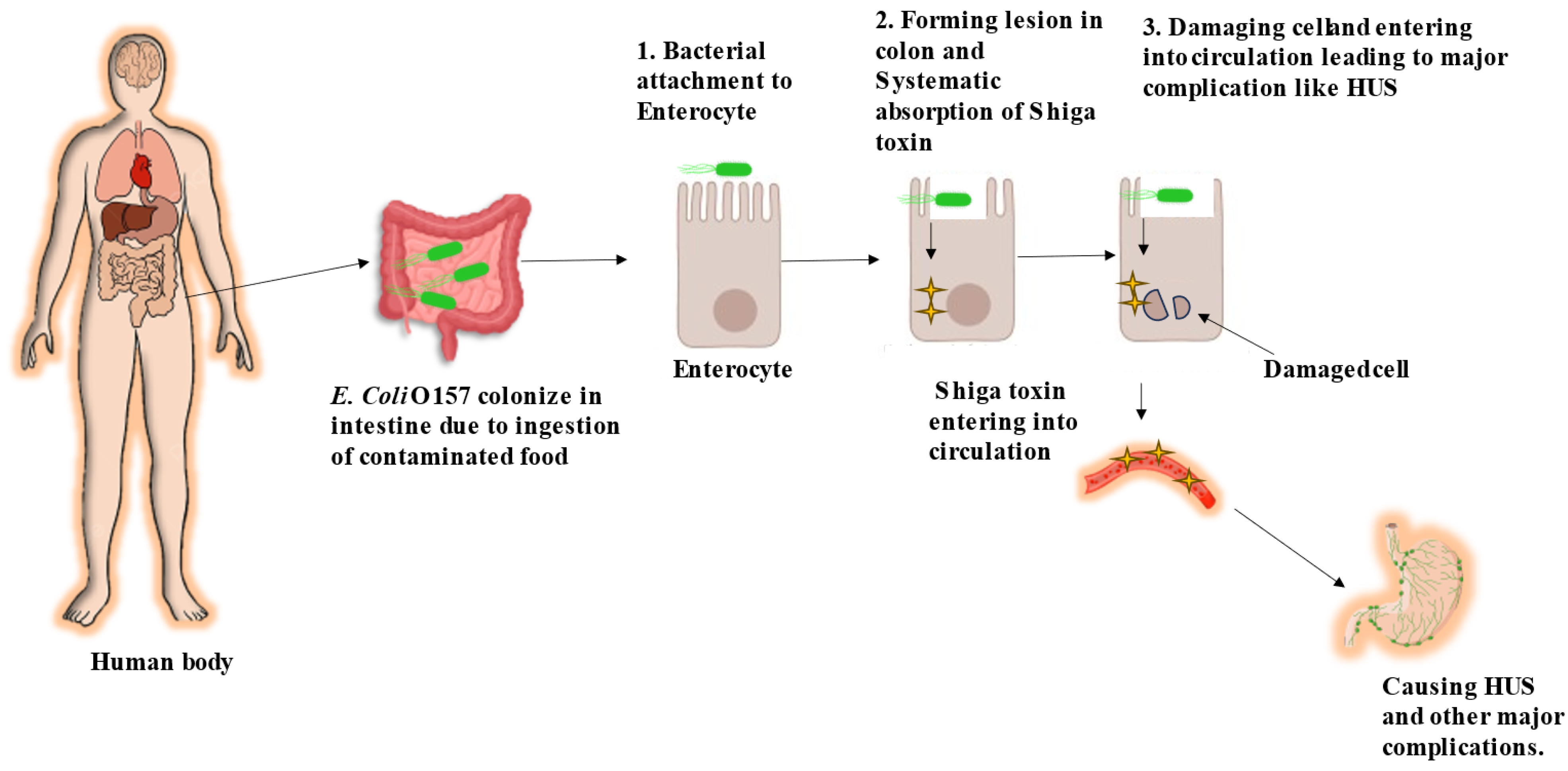

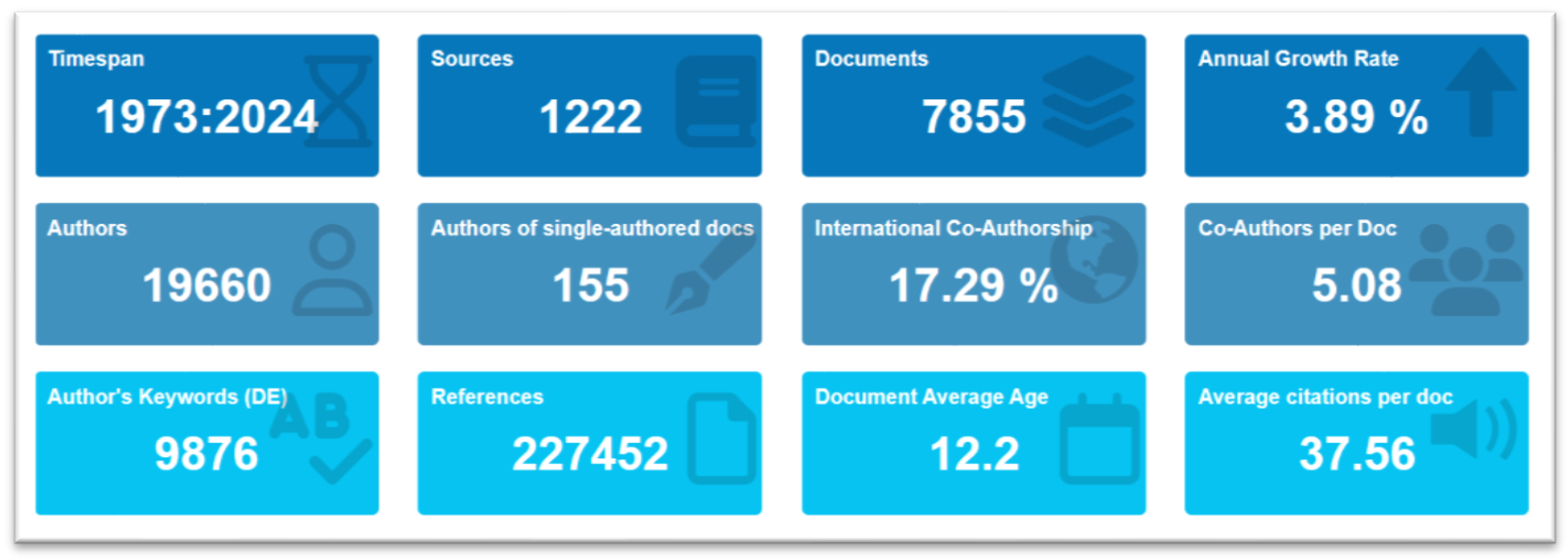
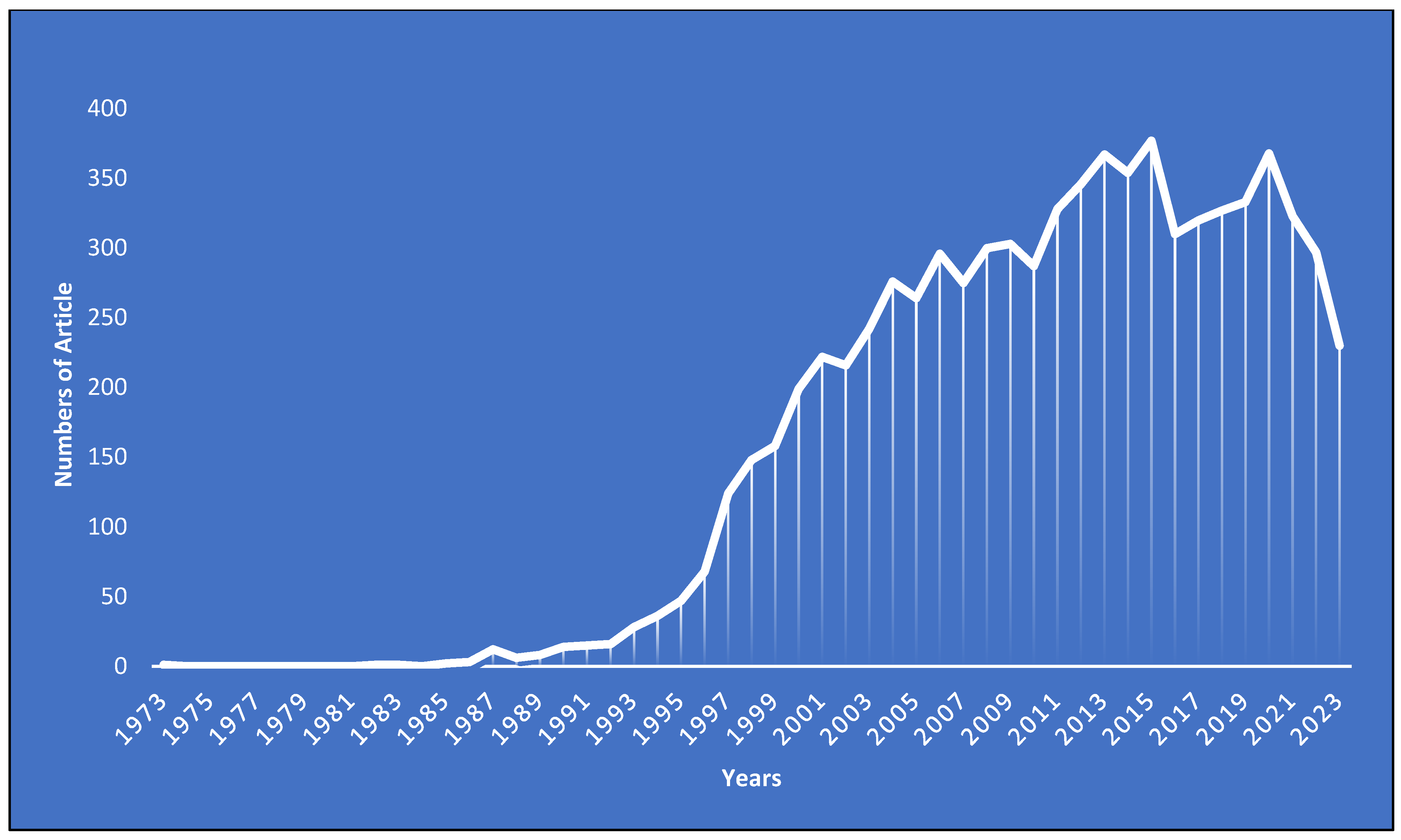
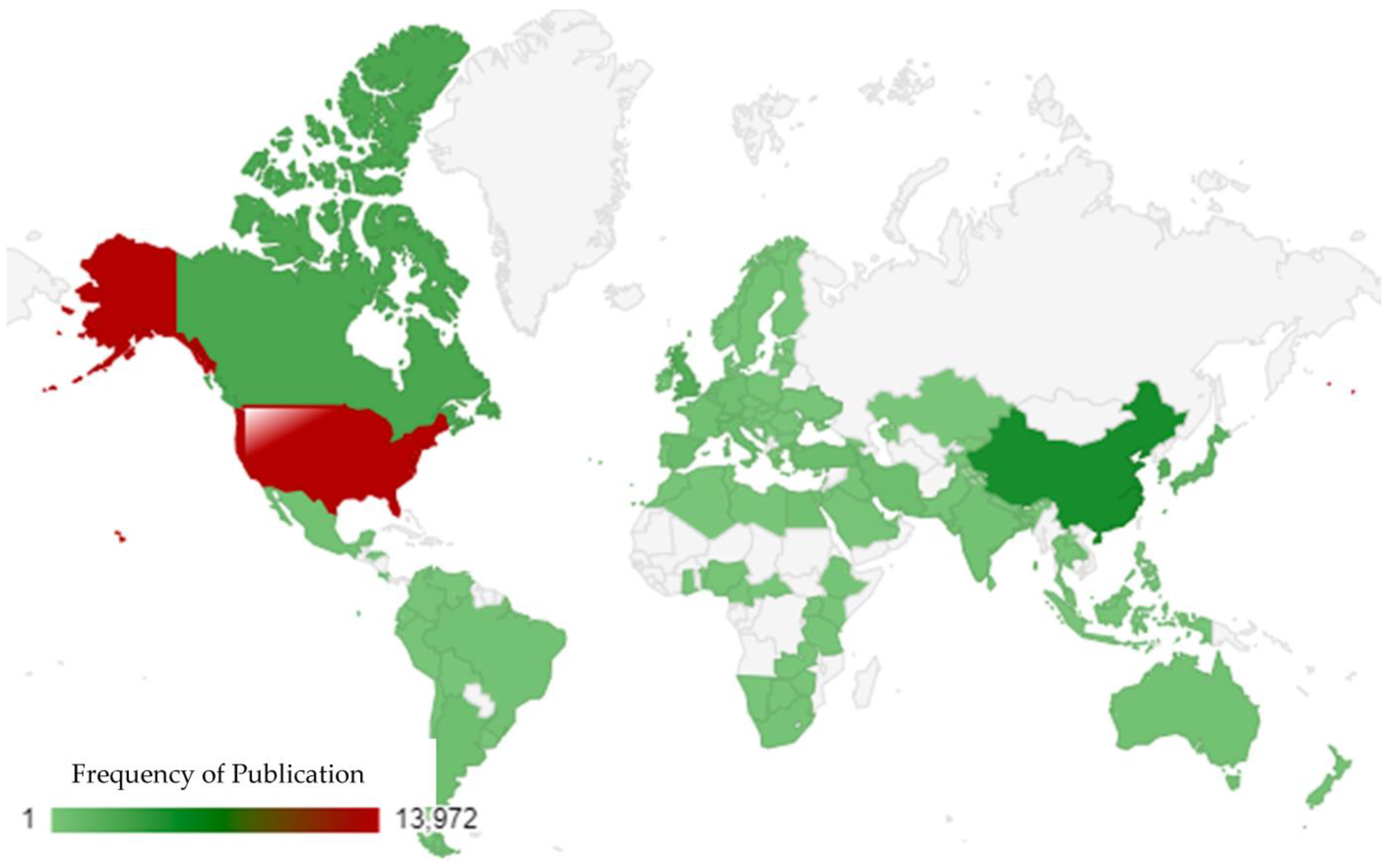

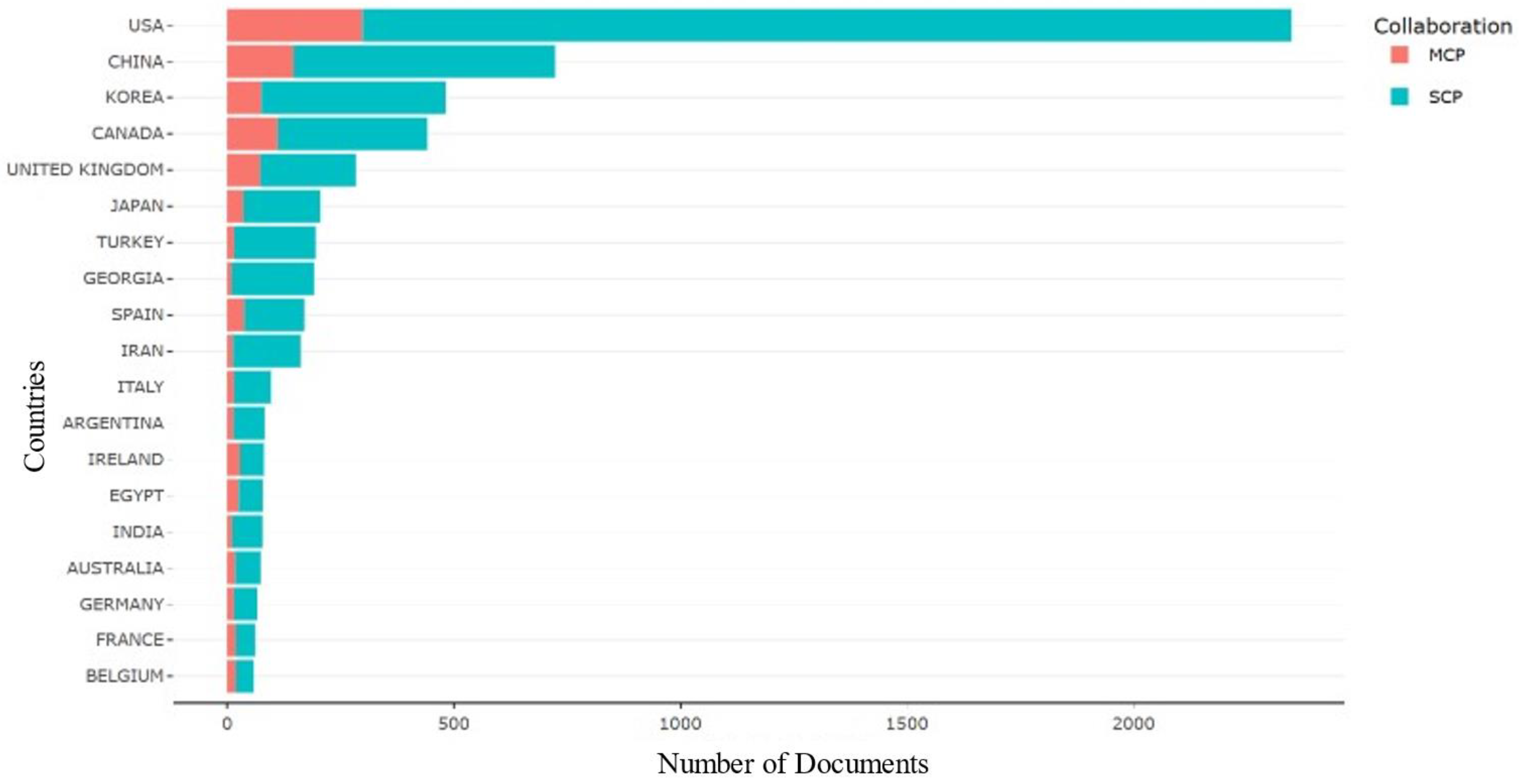
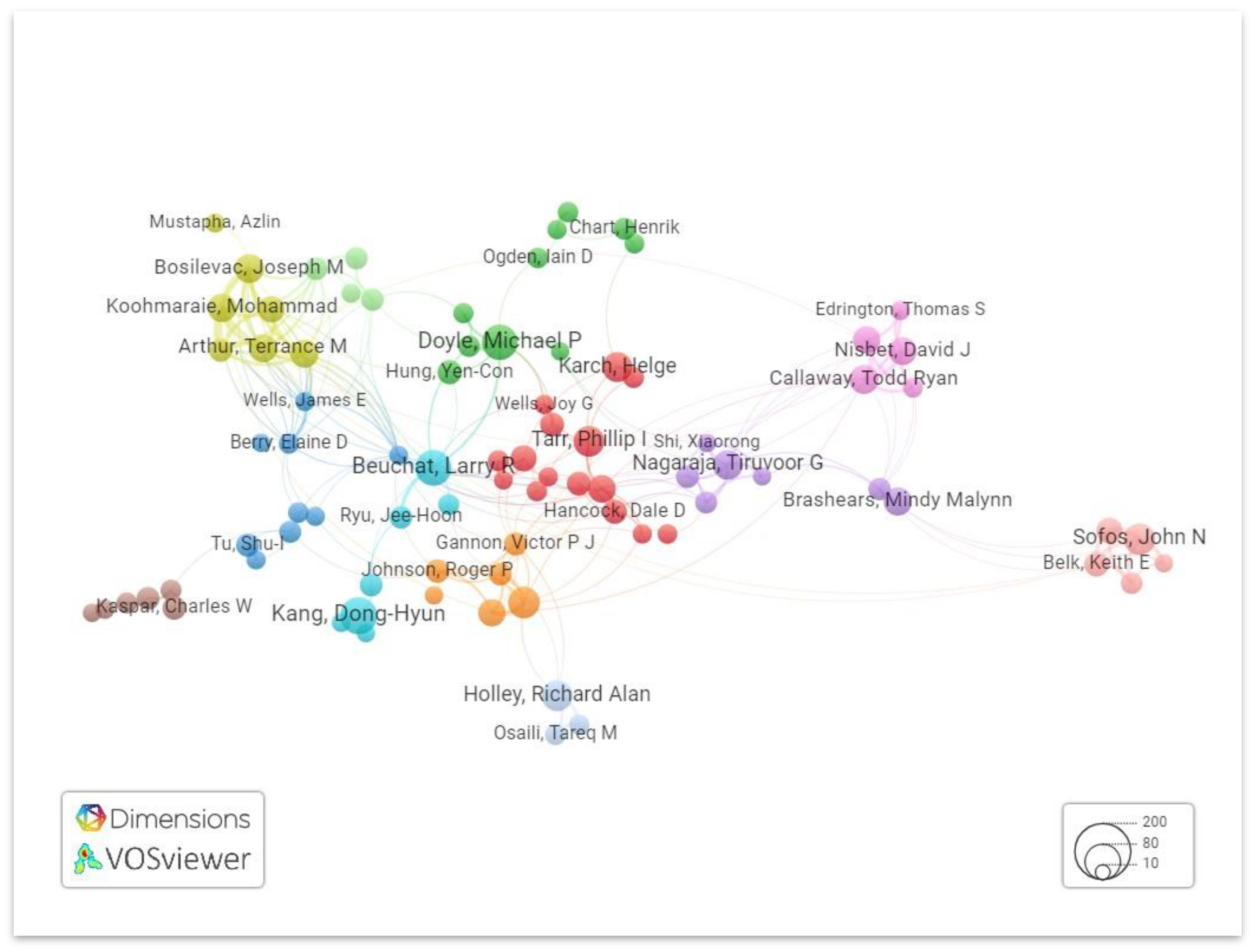
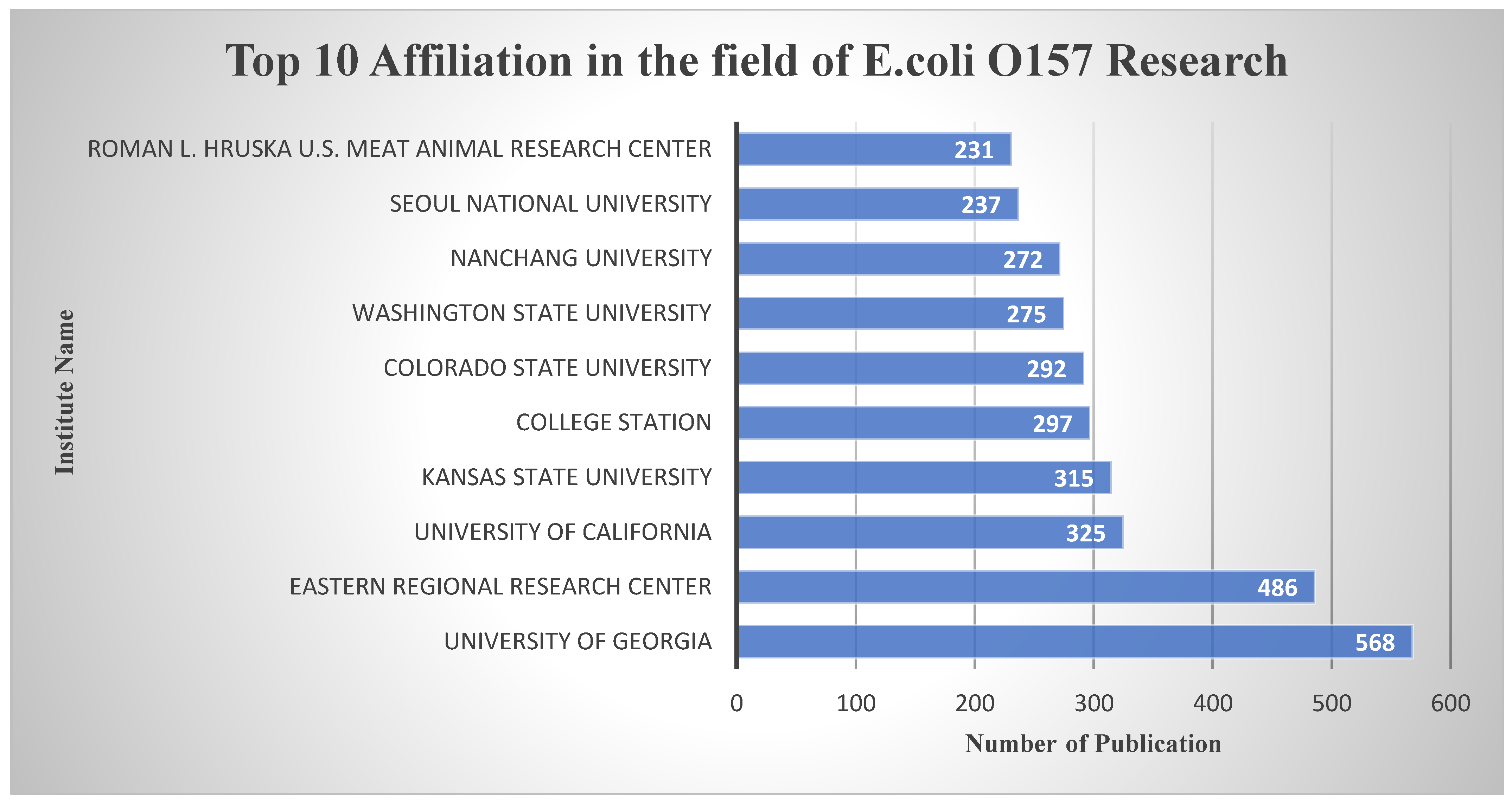
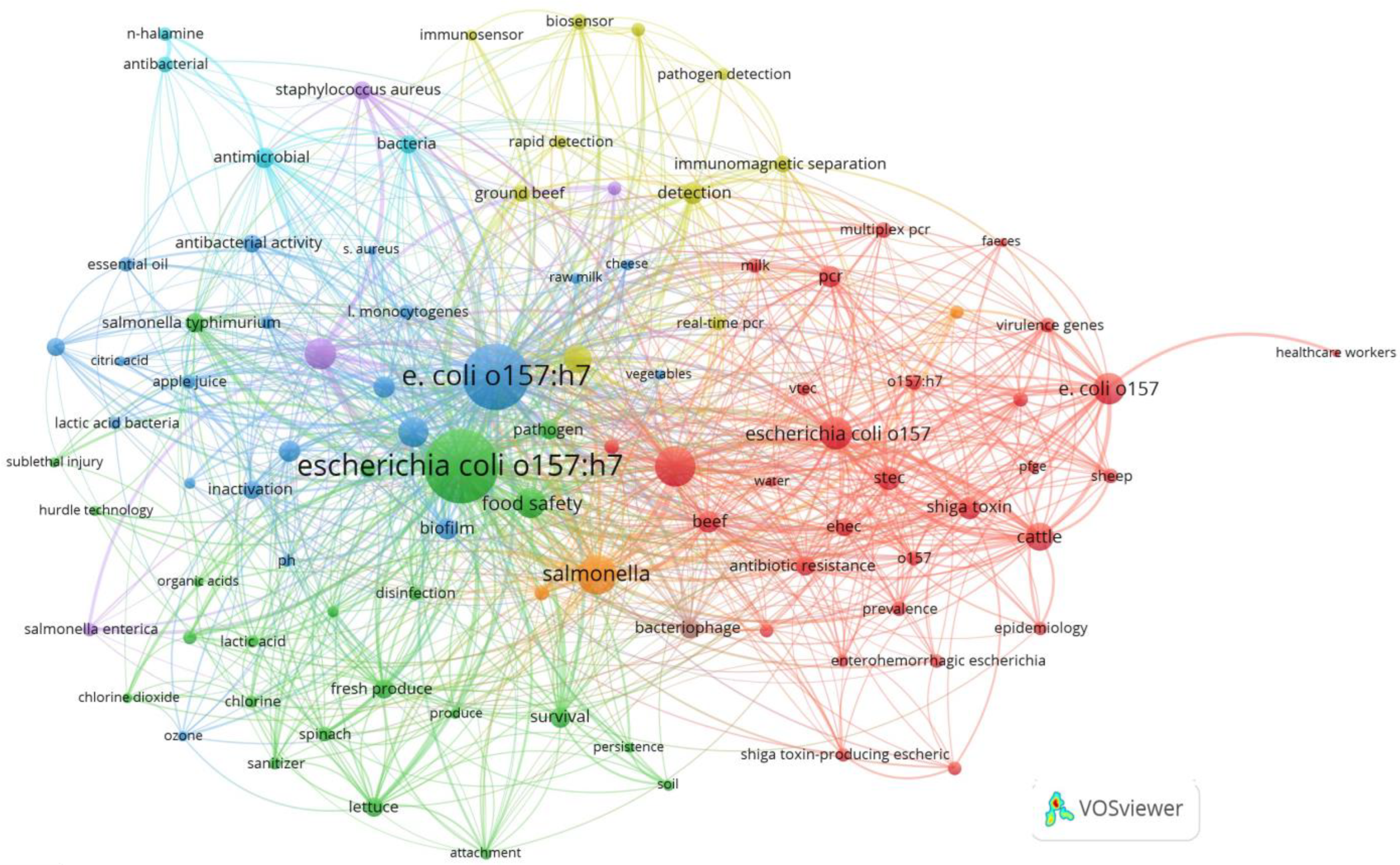
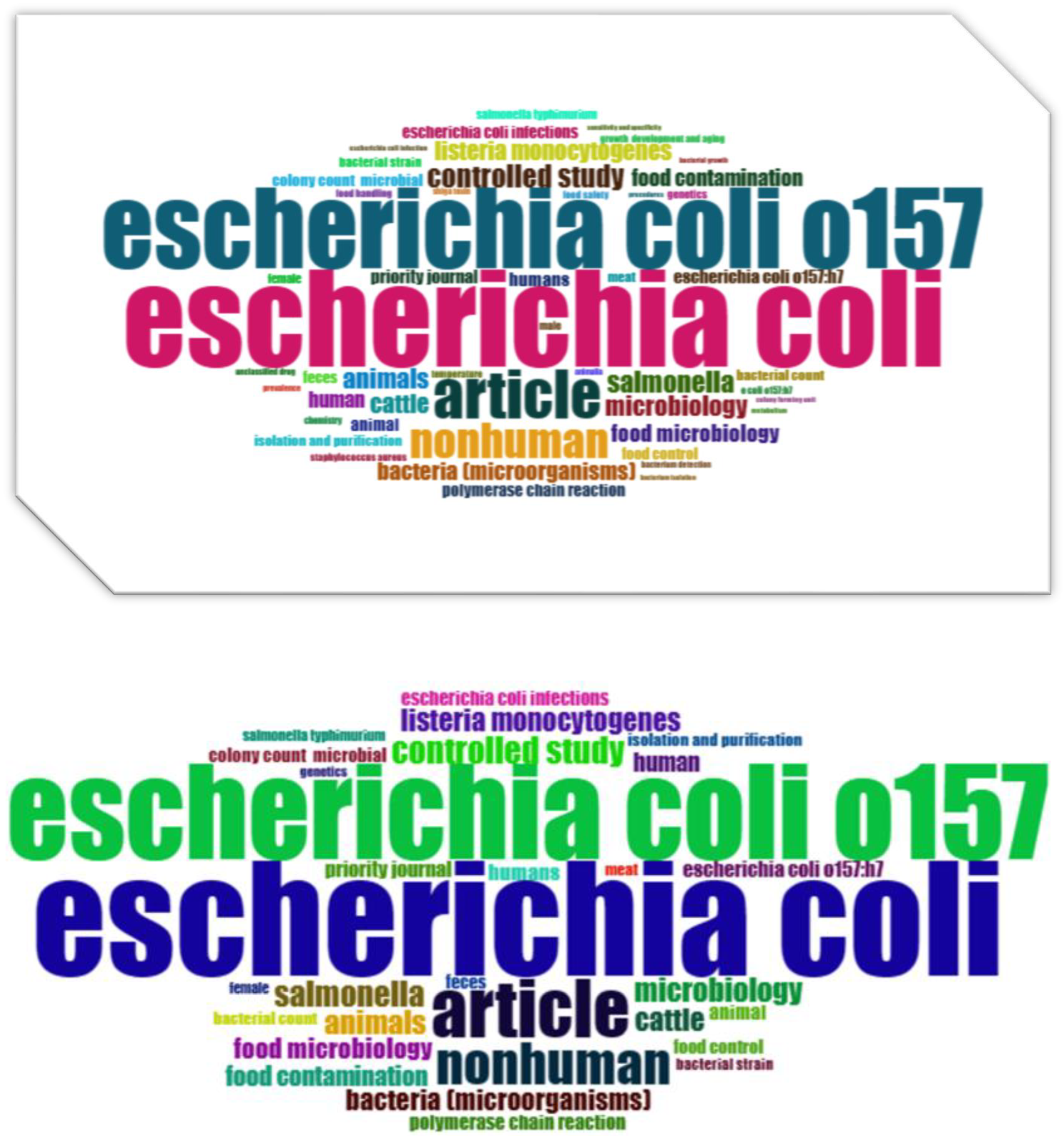
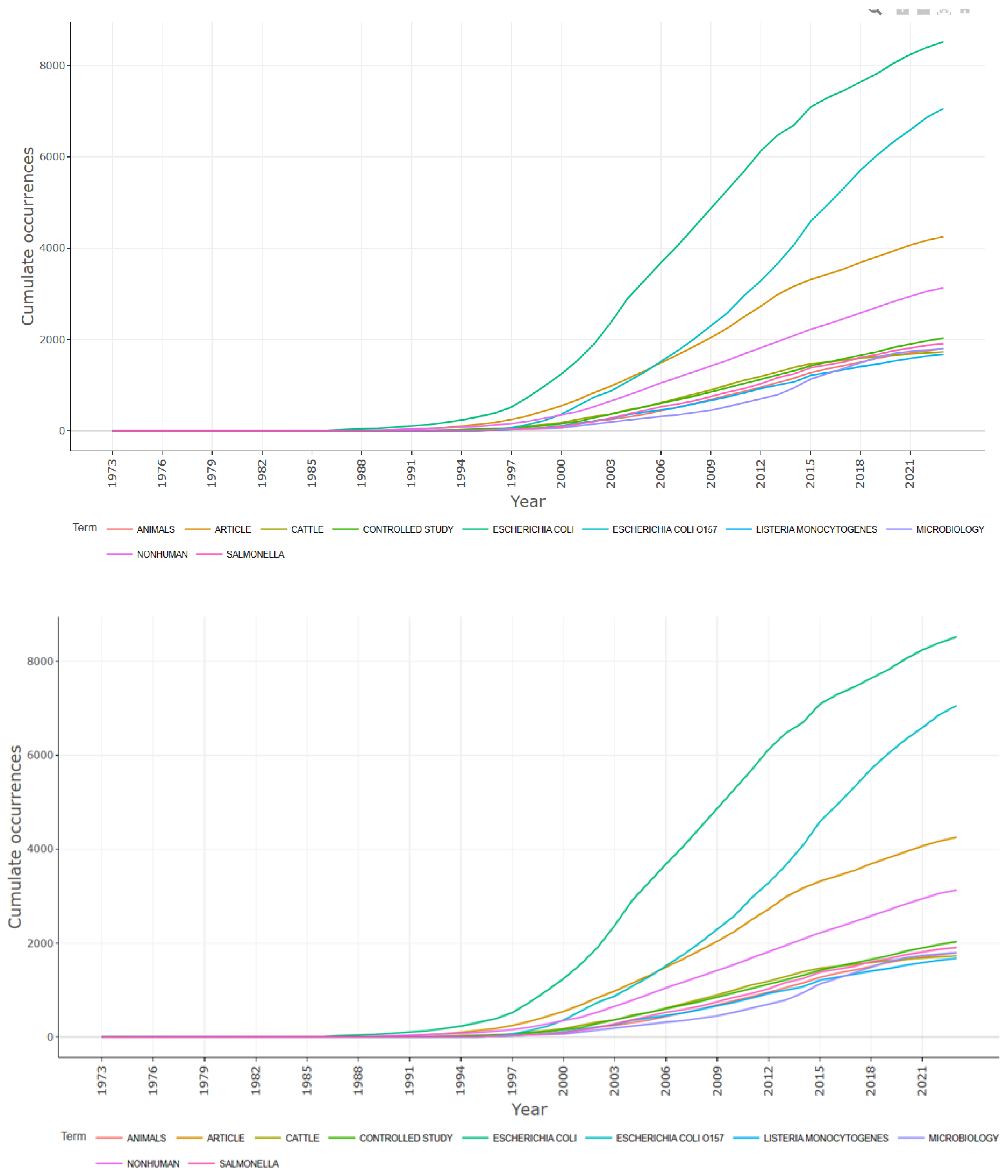
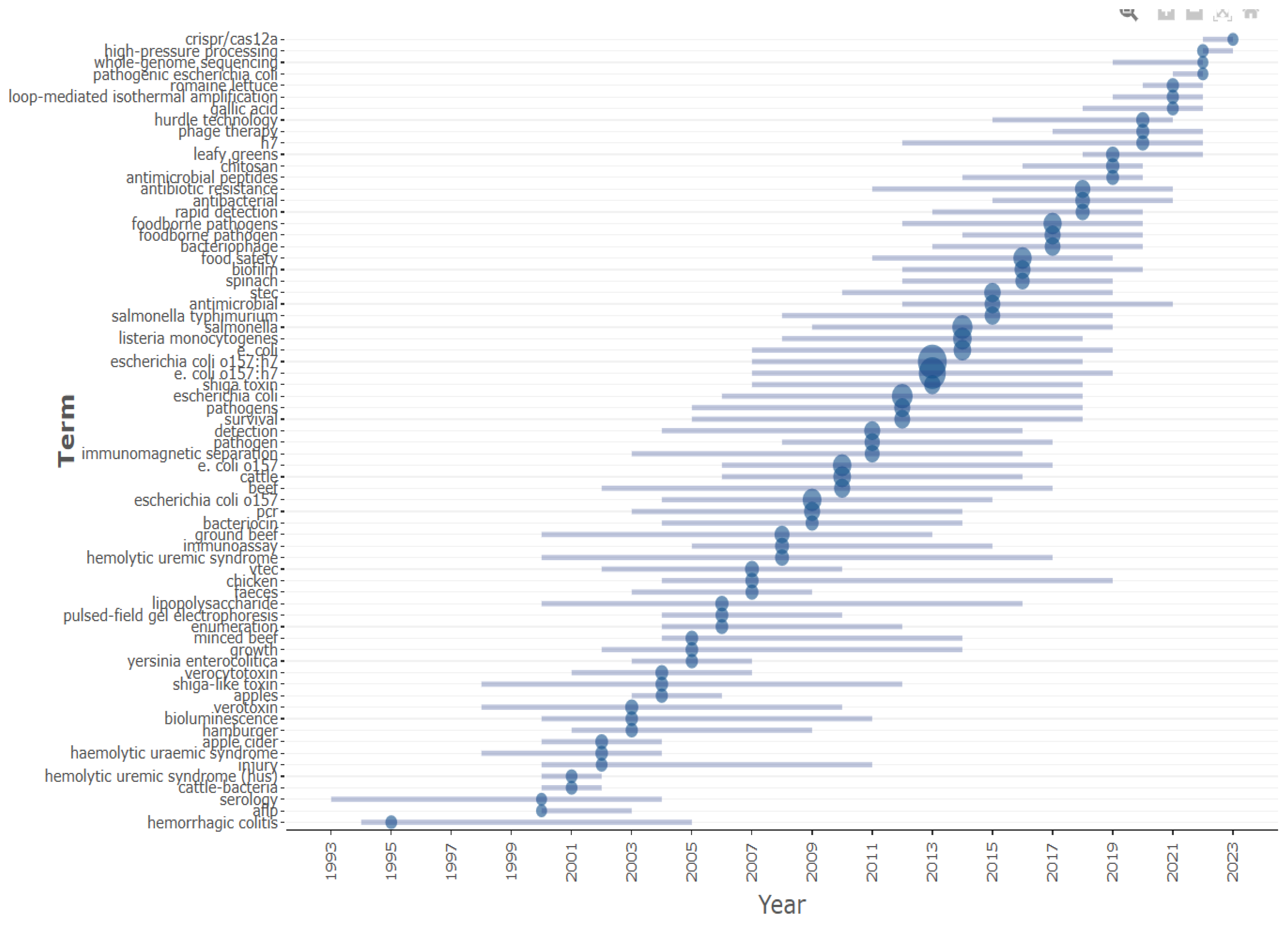
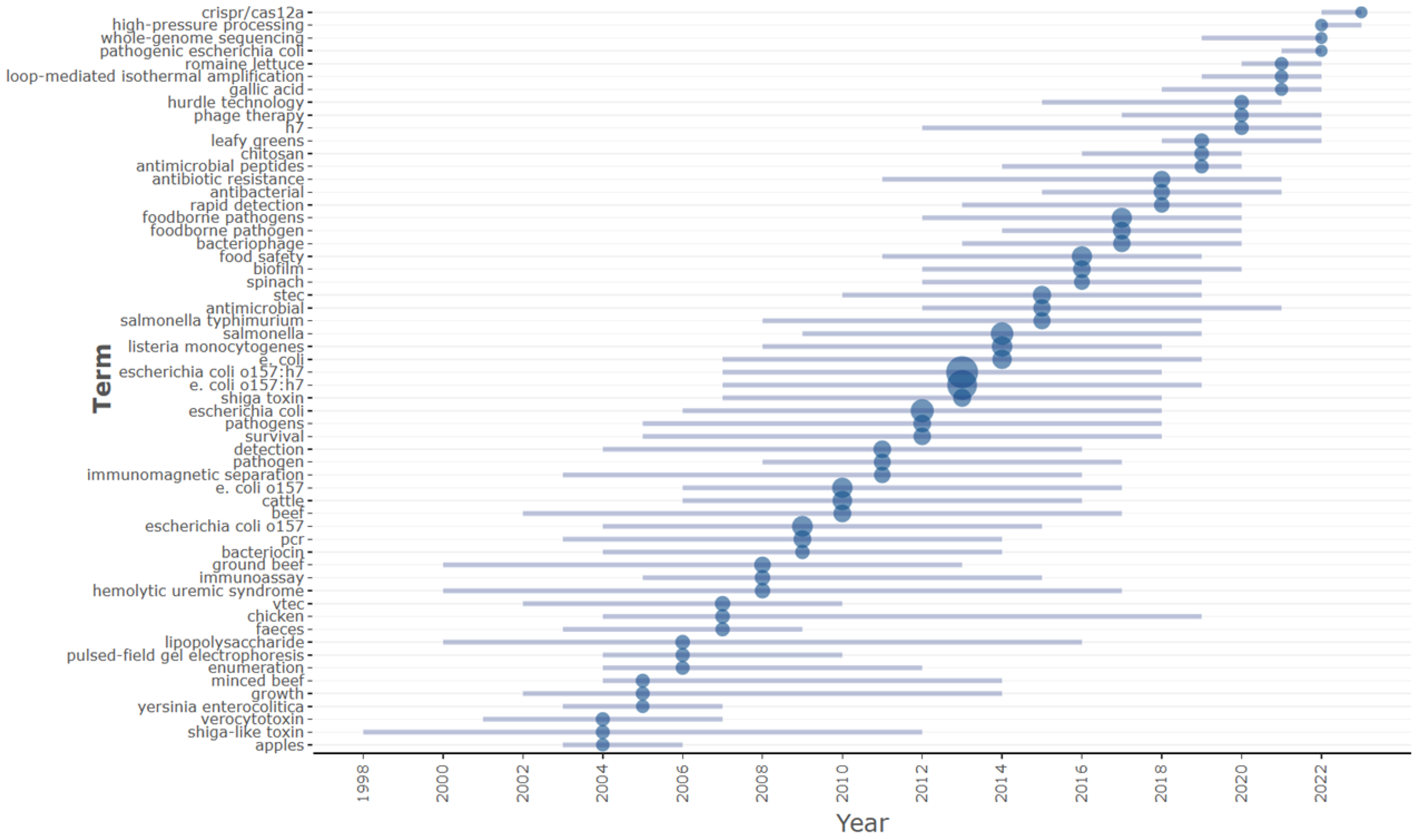

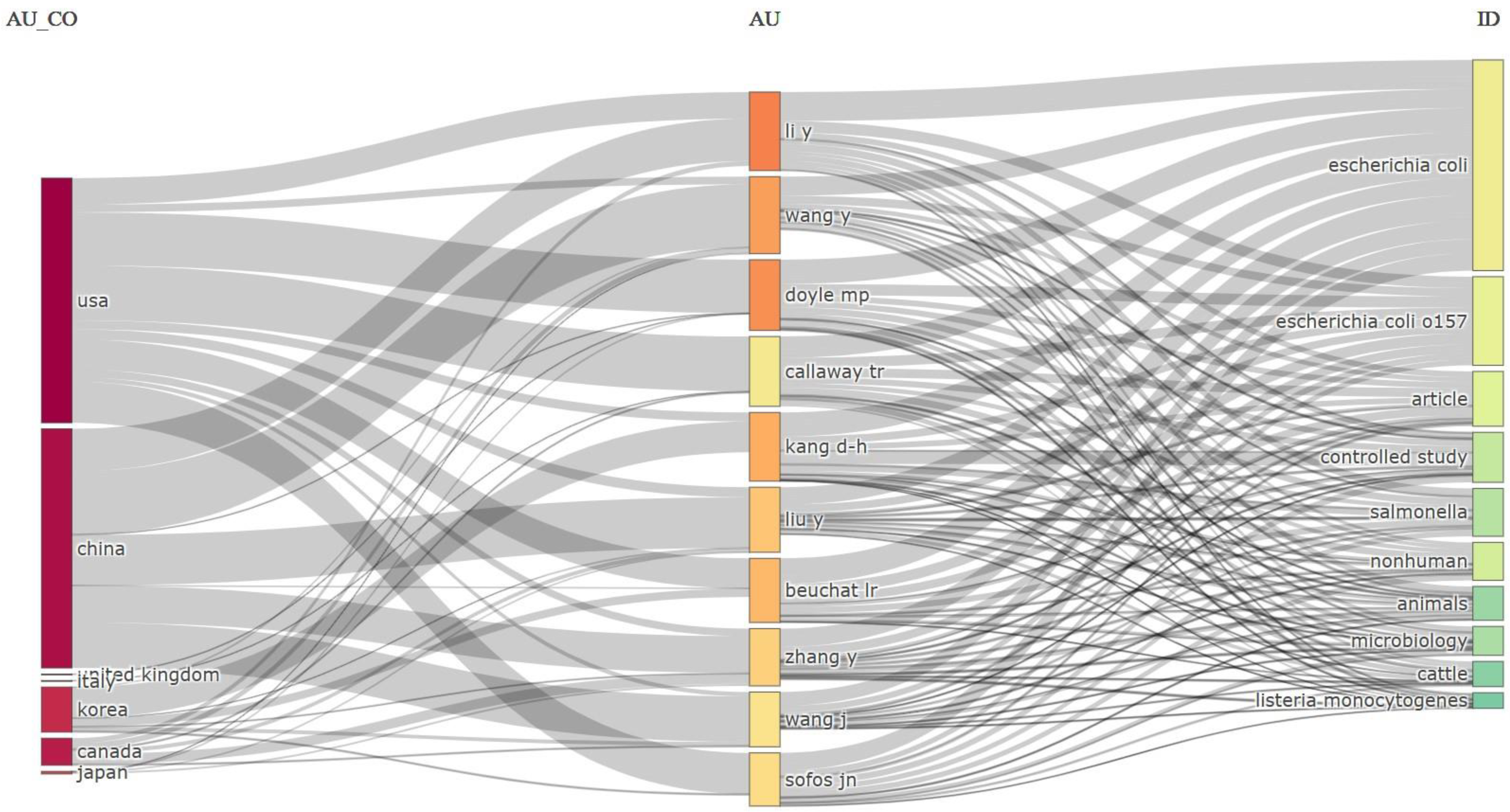

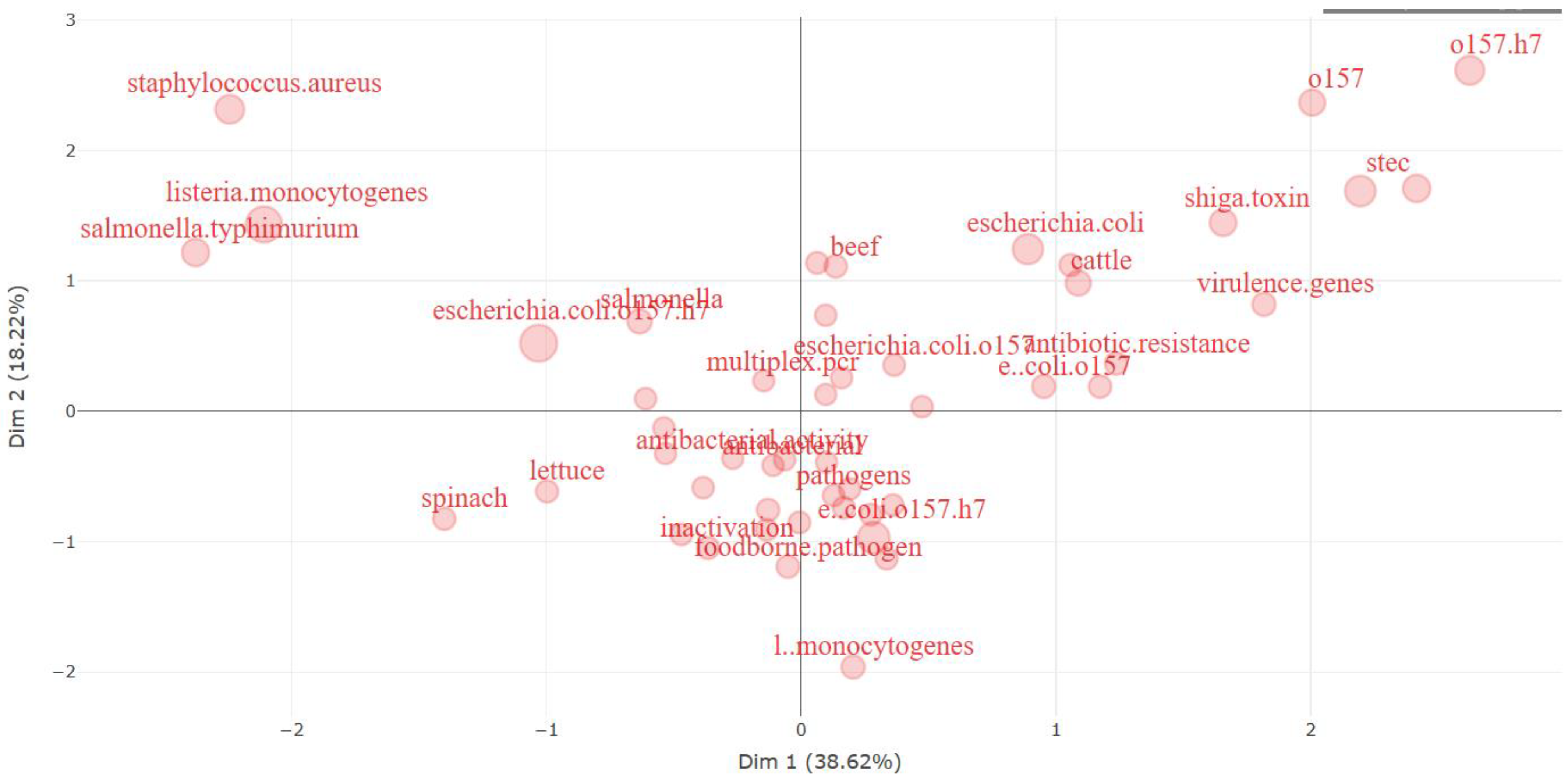
| Category | Antimicrobial Agent | Mechanism of Action | Effectiveness | Use in Treating E. coli O157 | Notes on Resistance | References |
|---|---|---|---|---|---|---|
| Traditional Antimicrobials | Ciprofloxacin | Inhibits DNA gyrase | Highly effective | Used for severe cases; oral and IV forms | Emerging resistance observed | [32] |
| Tetracycline | Protein synthesis inhibitor | Moderate effectiveness | Often used in veterinary settings | High levels of resistance reported | [33] | |
| Penicillin | Cell wall synthesis inhibitor | Limited effectiveness | Not typically used due to resistance | Widespread resistance | [34] | |
| Kanamycin | Aminoglycoside; inhibits protein synthesis | Effective against a broad range of bacteria | Used for serious infections; parenteral administration | Resistance can develop through enzymatic modification | [35] | |
| Cefoperazone | Third-generation cephalosporin; inhibits cell wall synthesis | Effective against Gram-negative bacteria | Used in serious bacterial infections | Resistance can occur via beta-lactamase production | [36] | |
| Streptomycin | Aminoglycoside; inhibits protein synthesis | Effective against a broad range of bacteria | Limited use due to resistance | High levels of resistance, especially in food animals | [37] | |
| Sulfisoxazole | Sulfonamide antibiotic; inhibits folate synthesis | Effective against Gram-negative bacteria | Limited use due to resistance | Resistance can develop through enzymatic pathways | [38] | |
| New or Alternative Antimicrobials | Carvacrol (Food Additive) | Disrupts cell membrane | Potent antibacterial effects | Potential use as a natural food antimicrobial | Less prone to resistance development | [39] |
| Sophorolipids | Disrupts cell membrane integrity | Greater activity than free-acid counterparts | Potential application in food and other industries | Emerging research, resistance not well characterized | [40] | |
| Bacteriophages | Target specific bacterial cells | Effective in reducing contamination | Used in the food industry and animal husbandry | Specificity reduces the chance of resistance | [41] | |
| Benzyl Isothiocyanate | Inhibits bacterial motility and toxin production | Effective against Salmonella and E. coli O157:H7 | Potential for reducing infection in food products | Limited data on resistance | [42] | |
| Coumarins | Reduce biofilm formation and virulence | Effective antivirulence strategies | Potential for reducing persistent infections without affecting growth | Research in progress; resistance potential not fully explored | [43] | |
| Citrus-Based Natural Extracts | Natural antimicrobials; mechanism varies | Variable inhibitory activity against E. coli O157:H7 | Could be used in pathogen-reduction strategies in foods | Natural origin may reduce resistance to development | [44] | |
| ε-Poly-L-Lysine | Disrupts membrane integrity, oxidative stress, and gene expression | Antibacterial against E. coli O157:H7 | Potential use in food preservation and safety | Emerging research, resistance mechanisms not yet clear | [45] | |
| Quercus infectoria and Punica granatum Extracts | Natural antimicrobial agents; mechanism not fully understood | Show significant inhibition of E. coli O157:H7 | Potential natural alternatives for reducing pathogens in food | Limited information on resistance development | [46] | |
| Probiotic Agents | Compete with pathogens for adhesion sites and nutrients | Mixed success in treating E. coli O157:H7 infections | Could reduce the risk of severe complications in infections | Generally low risk of developing resistance | [47] | |
| Plant-Derived Essential Oils | Various mechanisms, including membrane disruption | Variable effectiveness | Potential natural antimicrobials for food safety | Generally lower risk of resistance | [48] | |
| Silver Nanoparticles | Antimicrobial activity through multiple mechanisms | Effective against a wide range of microorganisms | Potential use in coatings and food packaging | Resistance mechanisms are less understood | [49] | |
| Lytic Enzymes | Degrade bacterial cell walls | Effective in targeting specific bacteria | Potential application in food safety and therapeutics | Specificity reduces the likelihood of resistance development | [50] | |
| Vanillin | Membrane depolarization and leakage of nucleic acids and proteins in the cell. | Highly Effective | Potential as a plant-derived antimicrobial. | Less resistance was reported. | [51] |
| S No. | Technique | Type | Sensitivity | Reference |
|---|---|---|---|---|
| 1. | Lateral flow immunoassay (LFIA) with silver enhancement | Immunoassay | Visual Limit of detection from 2 × 106 (CFU mL−1) to 2 × 103 (CFU mL−1) | [53] |
| 2. | Paper-based fluorescent phage biosensor with smartphone detection | Biosensor | Detection limit as low as 50 CFU/mL | [54] |
| 3. | Magneto-plasmonic nanosensor (MPnS) integrating SPR properties with T2 MR technology | Nanosensor | Detection as low as 10 CFUs | [55] |
| 4. | Phage-based luminescence detection assay during enrichment while the sample is in transit | Bioluminescence | The potential of using the ΦV10nluc phage-based luminescence detection assay during enrichment | [56] |
| 5. | Electrochemiluminescent (ECL) biosensor using NaBiF4 up-conversion nanoparticles | Biosensor | ECL behaviors of NaBiF4:Yb3+/Er3+ up-conversion nanoparticles for the detection of E. coli O157:H7 | [57] |
| 6. | Multiplex asymmetric PCR (MAPCR) with a chromogenic DNA microarray | PCR and DNA microarray technology. | The multiplex assay demonstrated outstanding sensitivity at 10 pg/μL and detection limits ranging from 104 to 105 CFU/25 g. | [58] |
| 7. | rRAA assay integrated with TOMA | Biosensor | The limit of detection was less than 10 CFU mL−1 | [59] |
| 8. | Loop-Mediated Isothermal Amplification (LAMP) | PCR | The test demonstrated a sensitivity of 100%, a specificity of 97.05%, and an efficiency of 97.5%. Additionally, it showed a negative predicted value of 100% and a positive predicted value of 85.7%. | [60] |
| 9. | Multivalent aptamer | Biosensor | Limit of detection of 10 cells per 250 mL | [61] |
| 10. | Colorimetric/fluorescent dual-mode immunochromatographic assay | Immunochromatographic | The detection limit of 9.06 × 101 CFU/mL | [62] |
| 11. | Colorimetric sensor | Biosensor | The detection limit of 116 CFU/mL. | [63] |
| 12. | Phage-apoferritin@CuO2 (phage-Apo@CP) probe | Biosensor | Limit of detection of 30 CFU/mL | [64] |
| 13. | ELISA with streptavidin scaffolded DNA tetrads | ELISA | The fluorescence ELISA exhibited a detection limit of 3.75 × 103 CFU/mL, which was 6.16 times superior to that of the conventional ELISA. | [63] |
| 14. | PMA-PSR (propidium monoazide-polymerase spiral reaction) | Dye-based reaction | With a specificity rate of 100%, PSR had the capability to quantify DNA quantities as minimal as 1.12 pg/μL. | [65] |
| 15. | PMA-mPCR | PCR | The mPCR assay demonstrated a detection limit of 103 CFU/mL in the culture broth, while the PMA-mPCR assay exhibited a detection limit of 104 CFU/mL in both pure culture samples. | [66] |
| 16. | Ultrasensitive and specific Phage@DNAzyme signal probe | Combination of phages and DNAzymes | The detection limit was 50 CFU/mL | [67] |
| 17. | Colorimetric Loop-Mediated Isothermal Amplification | Calorimetric | The cLAMP assay successfully identified 1 × 101 CFU/g at a temperature of 65 °C for both genes, and its specificity for E. coli O157:H7 was confirmed. | [68] |
| 18. | Nano enzyme-linked immunosorbent assay | ELISA | Detection sensitivity (8.7 × 102 CFU/mL) | [69] |
| 19. | RAA-CRISPR/Cas12a System | CRISPR-CAS | The method exhibited remarkable sensitivity, allowing the detection of as few as approximately 1 CFU/mL (using the fluorescence method) and 1 × 102 CFU/mL (using the lateral flow assay) of E. coli O157:H7. | [70] |
| 20. | Primer exchange reaction with glucose meter | Next-Generation Sequencing | The ability to identify E. coli O157:H7 with detection limits as minimal as 10 CFU/mL and within linear ranges of 10–107 CFU/mL was demonstrated. | [71] |
| Author | H-Index | G-Index | M-Index | Total Citation | Total Number of Publication | First Publication Year |
|---|---|---|---|---|---|---|
| Doyle MP | 49 | 84 | 1.256 | 9264 | 84 | 1985 |
| Li Y | 43 | 78 | 1.792 | 6240 | 102 | 2000 |
| Beuchat LR | 37 | 69 | 1.194 | 4868 | 77 | 1993 |
| Karch H | 35 | 47 | 0.946 | 3751 | 47 | 1987 |
| Tarr PI | 32 | 50 | 0.865 | 5073 | 50 | 1987 |
| Besser TE | 30 | 44 | 0.968 | 3709 | 44 | 1993 |
| Kang D-H | 30 | 48 | 1.2 | 2670 | 83 | 1999 |
| Wang Y | 28 | 55 | 1.077 | 3144 | 84 | 1998 |
| Arthur TM | 27 | 45 | 1.174 | 2492 | 45 | 2001 |
| Bosilevac JM | 27 | 45 | 1.286 | 2068 | 49 | 2003 |
| S No. | Keyword | Occurrence | Total Link Strength |
|---|---|---|---|
| 1. | Escherichia coli O157:H7 | 1065 | 2218 |
| 2. | E coli O157:H7 | 854 | 1771 |
| 3. | Escherichia coli | 328 | 761 |
| 4. | Salmonella | 298 | 926 |
| 5. | Escherichia coli O157 | 213 | 435 |
| 6. | Listeria monocytogenes | 202 | 637 |
| 7. | E. coli 0157 | 197 | 429 |
| 8. | Food safety | 189 | 457 |
| 9. | Foodborne Pathogens | 184 | 414 |
| 10. | Cattle | 159 | 461 |
| 11. | STEC | 109 | 335 |
| 12. | Shiga Toxin | 101 | 248 |
| 13. | Beef | 95 | 280 |
| 14. | PCR | 95 | 241 |
| 15. | Biofilm | 91 | 214 |
| S No. | Paper Title | Journal | Total Citation | Reference |
|---|---|---|---|---|
| 1 | “Genome sequence of enterohaemorrhagic Escherichia coli O157:H7” | Nature | 2460 | [86] |
| 2 | “Bifidobacteria can protect from enteropathogenic infection through production of acetate” | Nature | 2331 | [87] |
| 3 | “Complete Genome Sequence of Enterohemorrhagic Escherichia coli O157:H7 and Genomic Comparison with a Laboratory Strain K-12” | DNA Research | 1551 | [88] |
| 4 | “A genetic locus of enterocyte effacement conserved among diverse enterobacterial pathogens.” | PNAS | 1581 | [89] |
| 5 | “Epidemiology of Escherichia coli O157:H7 Outbreaks, United States, 1982–2002” | Emerging Infectious Disease | 1735 | [90] |
| 6 | “The Risk of the Haemolytic–Uremic Syndrome after Antibiotic Treatment of Escherichia coli O157:H7 Infections” | The New England Journal of Medicine | 1511 | [91] |
| 7 | “Pulse Net: The Molecular Subtyping Network for Foodborne Bacterial Disease Surveillance, United States” | Emerging Infectious Disease | 1362 | [92] |
| 8 | “An Outbreak of Diarrhea and Hemolytic Uremic Syndrome from Escherichia coli O157:H7 in Fresh-Pressed Apple Cider” | Jama Network | 1220 | [93] |
| 9 | “Quorum sensing in Escherichia coli, Salmonella typhimurium, and Vibrio harveyi: A new family of genes responsible for autoinducer production” | PNSA | 1291 | [94] |
| 10 | “Antibacterial activities of zinc oxide nanoparticles against Escherichia coli O157:H7” | Journal of Applied Microbiology | 988 | [95] |
| Journal | H-Index | G-Index | M-Index | Total Citations | Total Number of Publications | First Publication Year |
|---|---|---|---|---|---|---|
| Journal of Food Protection | 93 | 134 | 2.906 | 41,238 | 992 | 1992 |
| Applied and Environmental Microbiology | 91 | 143 | 2.333 | 25,604 | 323 | 1985 |
| International Journal of Food Microbiology | 80 | 119 | 2.424 | 20,869 | 379 | 1991 |
| Food Microbiology | 55 | 80 | 1.719 | 9776 | 264 | 1992 |
| Biosensors and Bioelectronics | 53 | 84 | 2.12 | 7234 | 96 | 1999 |
| Journal of Clinical Microbiology | 52 | 94 | 1.268 | 9072 | 101 | 1983 |
| Journal of Food Science | 52 | 81 | 1.733 | 8064 | 171 | 1994 |
| Food Control | 49 | 75 | 1.75 | 8460 | 252 | 1996 |
| Journal of Applied Microbiology | 49 | 87 | 1.815 | 8867 | 181 | 1997 |
| Infection and Immunity | 47 | 79 | 1.237 | 6354 | 80 | 1986 |
| Country | Total Citations | Average Article Citations |
|---|---|---|
| USA | 105,195 | 44.80 |
| Canada | 17,814 | 40.30 |
| China | 17,803 | 24.60 |
| United Kingdom | 12,612 | 44.40 |
| Korea | 11,282 | 23.40 |
| Georgia | 11,027 | 57.40 |
| Japan | 9190 | 44.60 |
| Spain | 8491 | 49.90 |
| Turkey | 4922 | 25.20 |
| Netherlands | 3497 | 85.30 |
Disclaimer/Publisher’s Note: The statements, opinions and data contained in all publications are solely those of the individual author(s) and contributor(s) and not of MDPI and/or the editor(s). MDPI and/or the editor(s) disclaim responsibility for any injury to people or property resulting from any ideas, methods, instructions or products referred to in the content. |
© 2024 by the authors. Licensee MDPI, Basel, Switzerland. This article is an open access article distributed under the terms and conditions of the Creative Commons Attribution (CC BY) license (https://creativecommons.org/licenses/by/4.0/).
Share and Cite
Jangid, H.; Kumar, D.; Kumar, G.; Kumar, R.; Mamidi, N. An Emerging Foodborne Pathogen Spotlight: A Bibliometric Analysis and Scholarly Review of Escherichia coli O157 Research. Antibiotics 2024, 13, 60. https://doi.org/10.3390/antibiotics13010060
Jangid H, Kumar D, Kumar G, Kumar R, Mamidi N. An Emerging Foodborne Pathogen Spotlight: A Bibliometric Analysis and Scholarly Review of Escherichia coli O157 Research. Antibiotics. 2024; 13(1):60. https://doi.org/10.3390/antibiotics13010060
Chicago/Turabian StyleJangid, Himanshu, Deepak Kumar, Gaurav Kumar, Raj Kumar, and Narsimha Mamidi. 2024. "An Emerging Foodborne Pathogen Spotlight: A Bibliometric Analysis and Scholarly Review of Escherichia coli O157 Research" Antibiotics 13, no. 1: 60. https://doi.org/10.3390/antibiotics13010060
APA StyleJangid, H., Kumar, D., Kumar, G., Kumar, R., & Mamidi, N. (2024). An Emerging Foodborne Pathogen Spotlight: A Bibliometric Analysis and Scholarly Review of Escherichia coli O157 Research. Antibiotics, 13(1), 60. https://doi.org/10.3390/antibiotics13010060










